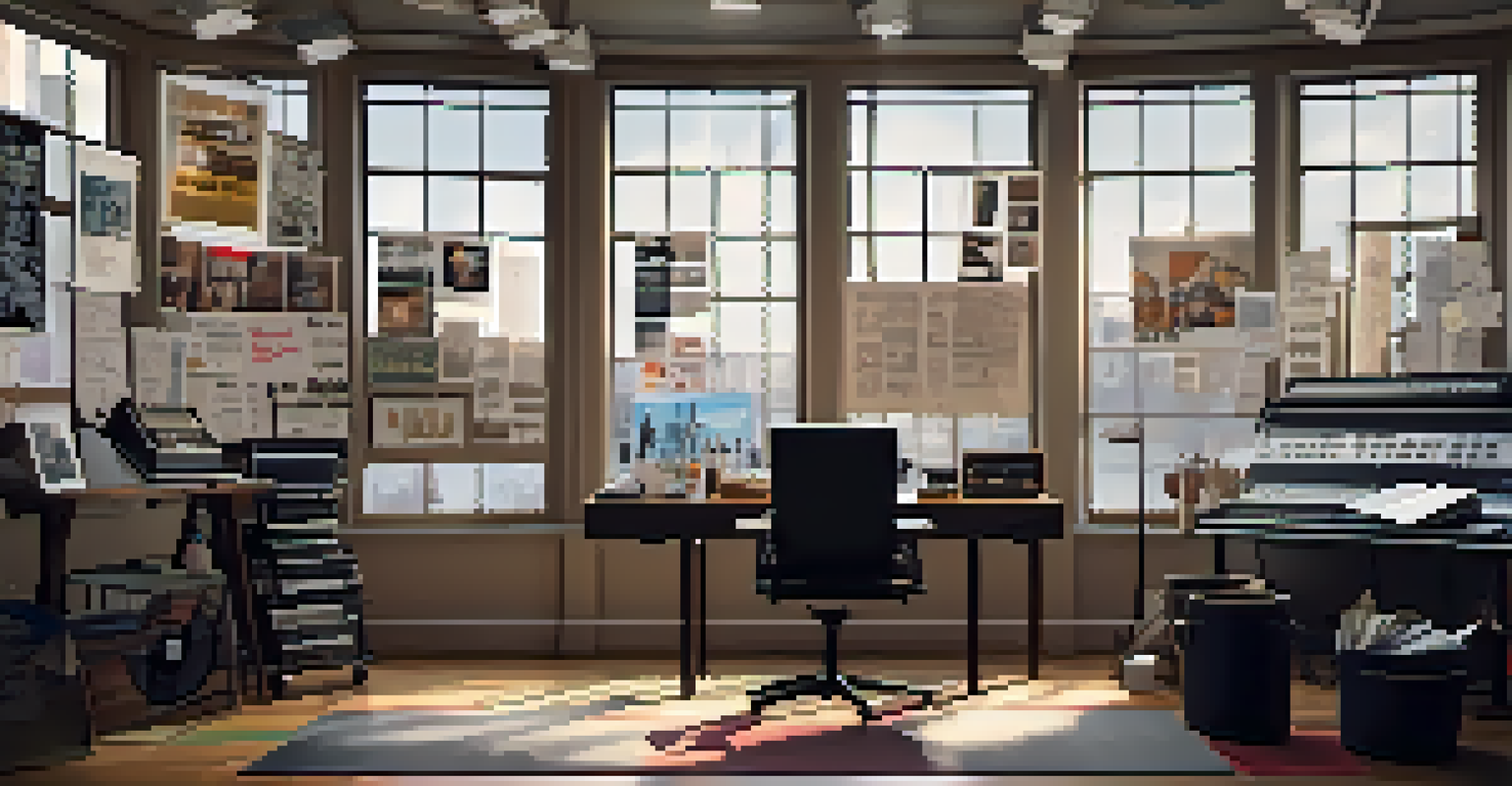The Director's Role in Building Cinematic Worlds and Atmosphere

Understanding the Director's Vision in Film
At the heart of every cinematic masterpiece lies the director's unique vision. This vision guides the film's narrative, characters, and overall aesthetic, setting the tone for the entire production. A director interprets the script, infusing it with personal insights and creative flair, which ultimately shapes how audiences engage with the film.
A film is never really good unless the camera is an eye in the head of a poet.
For instance, consider how directors like Christopher Nolan weave complex narratives that challenge viewers' perceptions of time and reality. His films, such as 'Inception,' are not just stories; they are intricate puzzles that require the audience's active participation. The director's vision is crucial in building a film's identity and emotional depth.
Ultimately, the director must communicate their vision effectively to the entire crew, from cinematographers to actors. This collaboration ensures that every element, from set design to lighting, aligns with the intended atmosphere, creating a cohesive cinematic experience.
Creating Atmosphere Through Cinematic Techniques
Atmosphere in film isn't just about visuals; it's a blend of sound, lighting, and editing that evokes emotions. Directors meticulously choose these elements to create immersive environments that draw audiences into the story. For example, the use of shadows and dim lighting can heighten tension, while vibrant colors may evoke joy or nostalgia.

Consider the film 'Her,' directed by Spike Jonze, where the soft color palette and ambient sound design create a futuristic yet intimate atmosphere. These choices influence how the audience connects with the characters and their emotions, making the world feel real and relatable. Atmosphere can even dictate the pacing of a story, enhancing suspense or providing relief.
Director's Vision Shapes Film
The unique vision of a director guides the film's narrative, characters, and overall aesthetic, influencing how audiences engage with the story.
By thoughtfully integrating various cinematic techniques, directors craft an atmosphere that resonates with viewers on a deeper level. This layered approach not only enriches the narrative but also leaves a lasting impression, making the film memorable long after the credits roll.
Building Authentic Worlds with Set Design
Set design plays a pivotal role in establishing the film's world. Directors collaborate with production designers to create spaces that reflect the story's context, culture, and time period. The attention to detail in set design can transport viewers to entirely different realms, from the opulence of a royal palace to the starkness of a post-apocalyptic landscape.
The director is the one who has to pull it all together and make it coherent, and that’s a big responsibility.
Take 'The Grand Budapest Hotel,' directed by Wes Anderson, as an example. The meticulously crafted sets, vibrant colors, and quirky elements create a whimsical yet nostalgic atmosphere that is instantly recognizable. Here, the set becomes a character in its own right, enhancing the storytelling and emotional impact.
Ultimately, a well-designed set invites viewers to lose themselves in the film's world. When audiences believe in the authenticity of the environment, they become more engaged with the narrative, allowing deeper emotional connections with the characters and their journeys.
The Director's Role in Guiding Performances
A director's influence extends beyond technical aspects; they are also responsible for guiding actors' performances. By fostering a collaborative atmosphere, directors encourage actors to explore their characters deeply, bringing authenticity to their roles. This relationship is crucial, as strong performances can elevate the film's emotional resonance.
For instance, in 'The Revenant,' Alejandro Iñárritu worked closely with Leonardo DiCaprio to create a raw, visceral portrayal of survival. This collaboration not only resulted in an Oscar-winning performance but also helped craft the film's intense atmosphere. The director's ability to elicit powerful performances is key to immersing the audience in the story.
Atmosphere Created Through Techniques
Directors use sound, lighting, and editing to create immersive atmospheres that evoke emotions and enhance the viewer's connection to the film.
In essence, directors serve as both visionaries and facilitators. By nurturing actors' talents and providing clear direction, they ensure that performances align with the film's overall tone, enriching the cinematic experience for viewers.
Utilizing Music to Enhance Cinematic Atmosphere
Music is a powerful tool in film that can evoke a wide range of emotions. Directors often work closely with composers to create soundtracks that complement the film's narrative and atmosphere. Whether it's a haunting score or an upbeat song, music can significantly influence how audiences perceive and feel about a scene.
For example, in 'Interstellar,' Hans Zimmer's score enhances the film's themes of love and exploration, creating a sense of wonder and urgency. The music not only underscores pivotal moments but also deepens the emotional impact, leaving a lasting impression on viewers. This synergy between music and visuals is vital for crafting an immersive experience.
Ultimately, a director's careful selection of music can elevate a film from good to great. By weaving together sound and visuals, directors create a rich tapestry that resonates with audiences, enhancing their overall cinematic journey.
The Impact of Editing on Cinematic Worlds
Editing is often described as the invisible art of filmmaking, yet it plays a crucial role in shaping the final product. Directors work closely with editors to determine the pacing, rhythm, and flow of the film, which ultimately affects the audience's experience. Well-edited scenes can create tension, build suspense, or provide relief, guiding viewers through the narrative.
Take the film 'Mad Max: Fury Road,' directed by George Miller, where rapid cuts and dynamic editing amplify the film's exhilarating pace. The editing choices not only enhance the action but also contribute to the film's chaotic atmosphere, immersing the audience in a post-apocalyptic world. This seamless collaboration between director and editor is vital for achieving the desired impact.
Editing Refines Cinematic Experience
The editing process is crucial in shaping the film's pacing and flow, helping to maintain audience engagement and enhance the overall impact.
In essence, the editing process allows directors to refine their vision, ensuring that every frame serves a purpose. By carefully crafting the flow of the film, directors maintain the audience's engagement, making the journey through the cinematic world both compelling and memorable.
The Director's Influence on Audience Perception
A director's choices significantly shape how audiences perceive a film. From the initial concept to the final cut, every decision impacts viewers' emotions and interpretations. Directors have the power to challenge conventions, provoke thought, and elicit emotional responses, ultimately guiding the audience's journey through their cinematic world.
For instance, in 'Get Out,' Jordan Peele masterfully blends horror with social commentary, prompting viewers to reflect on deeper societal issues. This intentionality in directing helps create a rich atmosphere that transcends mere entertainment, encouraging audiences to engage with the film's themes critically.

Ultimately, a director's influence extends beyond the screen; it shapes cultural conversations and perceptions of the medium. By crafting compelling narratives and immersive atmospheres, directors leave a lasting imprint on the audience, making their films impactful and thought-provoking.